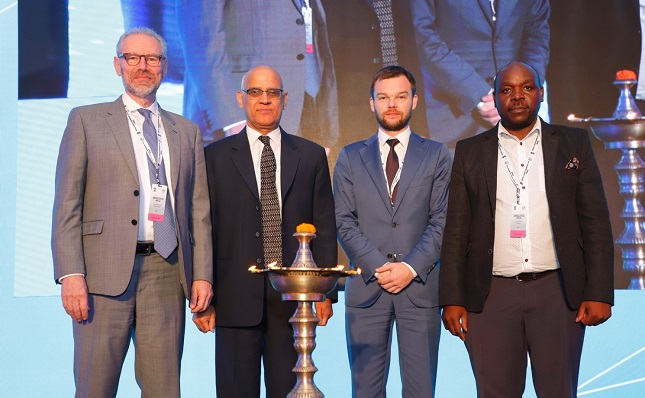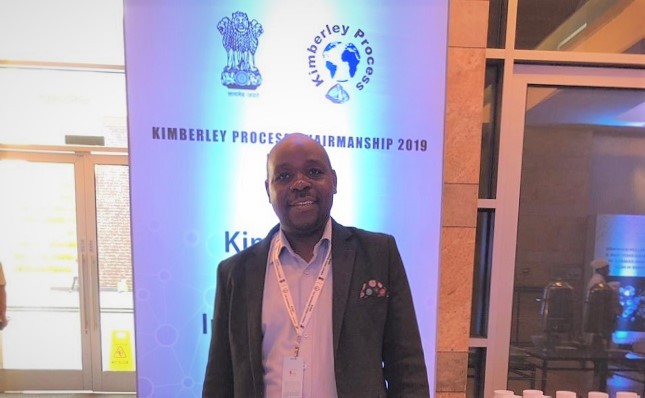Diamond News Archives
- Category: News Archives
- Hits: 822

Shamiso Mtisi, the Zimbabwean lawyer who heads the Kimberley Process (KP) Civil Society Coalition (CSC), who addressed the Opening Session of the Kimberley Process Intersessional Meeting (KPI) in Mumbai, India, emphasized that the discussions on the broadening of the KP scope, meaning the broadening of the term 'conflict diamonds' to included human rights violations, should not raise anxieties about possible adverse impacts on trade. He said that rather, the reverse is intended. Addressing the governmental and industry delegates in the room, he said: "Indeed, it is you that hold the reigns to ensuring that [this does not happen]."
"KP observers have made it clear that any new KP mandate would need to be applied in a fair and impartial way that can support rather than penalize states. Civil society for example is not looking for the imposition of nationwide embargoes or sanctions. We recognize that this is not always the most effective intervention. It is precisely through the KP that states facing cases of violence or other forms of abuse should be able to seek the support needed to address them.
There are a range of possible interventions, including better formalization of artisanal mining and training for security forces. For example, in Zimbabwe, the Zimbabwe Consolidated Diamond Mining Company (ZCDC) on its own accord, has so far organized three Diamond Security Conferences that brought together communities, civil society, Government, mining companies and State and private security forces to discuss the situation in Marange. ZCDC has also been planning to seek support for training of its staff and private security personnel on human rights.
In Sierra Leone, Government has been working closely with civil society groups through a tripartite system to address problems...
- Category: News Archives
- Hits: 773
HTTP/2 200 content-type: text/html; charset=utf-8 server: nginx/1.12.2 x-powered-by: Express x-request-id: b7a33bbc-48ca-479f-8721-df962e99ca61 access-control-allow-origin: * x-aicache-os: 172.31.14.145:81 x-aicache-os: 52.72.178.210:80 cache-control: max-age=15 expires: Tue, 18 Jun 2019 20:00:20 GMT date: Tue, 18 Jun 2019 20:00:05 GMT set-cookie: region=USA; expires=Mon, 16-Sep-2019 20:00:05 GMT; path=/; domain=.cnbc.com vary: User-Agent ...
Senators' bipartisan bill cracks down on shell companies and money laundering- Category: News Archives
- Hits: 842

Economic weakness is already global and very likely to be measured as recessionary in backward-looking assessments months hence. Falling revenues globally are intensifying a cash crunch and drawing capital flows out of emerging markets and currencies and into the most liquid assets such as treasuries and US cash. This is typical during global downturns, and especially when the world is encumbered with high levels of U$ denominated debt, as it is today.
For Canadians, an allocation in investment portfolios to the US dollar can be a rare place to make a capital gain on currency when other risk assets are falling. A practical caveat, however, is that it’s still prudent to keep the bulk of our savings in the currency in which we pay the bulk of our expenses. If most of our expenses are in loonies, then it is defensive to keep the majority of our funds in Canadian denominated assets even when the currency is weakening as against the greenback.
Another point to keep in mind is that once bear markets begin, all risk assets–commodities, corporate bonds and equities–dividend paying and not–tend to fall in value together. Suggesting that one hold consumer staples, or pipelines, utilities or financials as ‘defensive’ sectors, is code for saying that ‘defensive’ sectors or companies still go down in bear markets but any dividends received (3 or 4%) will help to lessen the overall loss incurred (ie., -25% capital loss -4% dividend received is a 21% loss rather than 25%).
While this may sound good in theory, in reality, dividends are woefully insufficient compensation for the losses and trauma experienced. This is particularly so, when people are withdrawing dividends received as income and so there is no reinvestment of them into cheaper shares as prices fall. It is...
- Category: News Archives
- Hits: 835

Shamiso Mtisi, the Zimbabwean lawyer who heads the Kimberley Process (KP) Civil Society Coalition (CSC), was one of the three speakers who addressed the Opening Session of the Kimberley Process Intersessional Meeting (KPI) on June 17, in Mumbai, India.
In his address Mtisi noted that this year is the KP's last chance, in the current reform cycle, to cut the diamond sector's ties to what is considered by both consumers and communities to be blood diamonds. He said that "despite two and a half years since KP reform discussions started in Australia, there has still been no substantive discussion on proposals or content regarding expanding the KP's scope, nor on mechanisms to enable it to address emerging issues, like violence and conflict in an impartial and effective manner."
Time should not be wasted, Mtisi warned. "Consumer resistance to unethically mined diamonds and millennial demands for clean diamonds is real and not imagined. Where diamond production involves conflict or violence, it threatens both KP relevance and long-term revenues - that is, sustainable development for producer states. It does so by fueling ethical concerns about the sector as a whole. The damage here is not limited to those countries where these issues arise."
The African producing states are the ones that stand to lose the most and are facing two major threats: The failure of the KP to address serious ethical issues and the rise of synthetic diamonds, Mtisi said.
He emphasized that the responsibility for KP reform lies with the participating governments. "So far, many participants have been shielded or benefited from the impact of consumer preferences for ethical stones. Changing dynamics in the luxuries market and for the...
- Category: News Archives
- Hits: 1112
$XAU, $GLD, $USD
Mr. Market started seriously pricing in the possibility of interest rate cuts.
To be fair, the signal came from the Top of the economic politburo that matters that being the Federal Reserve.
Speaking at an event at the Chicago Fed last Tuesday, Chairman Jerome Powell hinted that the Fed would likely cut rates to keep the economic expansion going.
With stocks still within 10% of their all-time highs, the soothing words may just be enough to avoid another selloff.
But it may also finally spark the final late-Bull market rally that gets fearful investors to throw away the fear and embrace the greed.
That’s how Bull markets die, not of old age. They die on speculative greed, as in Y’s 1929, 2000, and 2008 among other dates in between.
Consequently, the market is vastly increasing the odds of a cut in interest rates by the end of the year, maybe even 2 years.
Given that interest rates are at 2%, and at this stage in past market rallies they have been averaging closer to 4-6% that is not a huge vote of confidence on the economy right now.
In other words, the Fed is spiking the punchbowl while we’re still riding the euphoria of the near-Zero % interest rates of Ys’ 2008-2015.
The job of the Fed is to be just the opposite.
Fed Chairman William McChesney Martin, who headed the agency from Ys 1951 to 1970, is best known today for saying it’s the Fed’s job to take away the punch-bowl as the party gets going.
But that is the Fed at work. Rather than try to act as a brake on the economy when it’s running hot, or getting...

